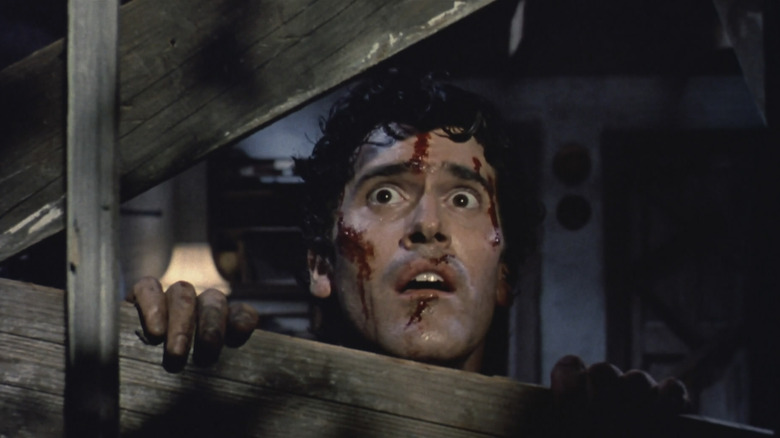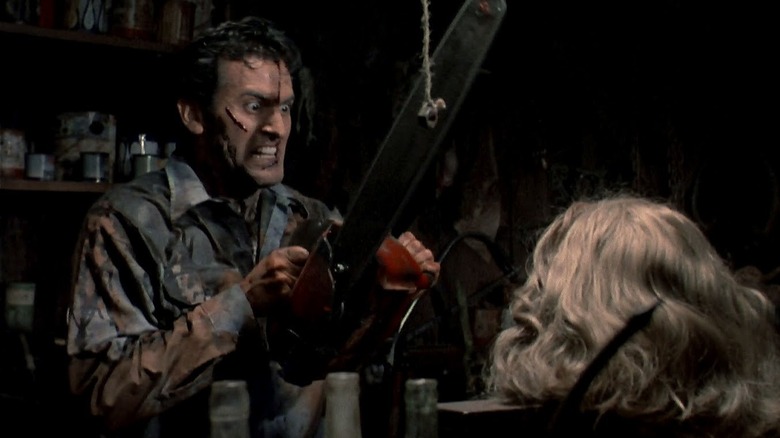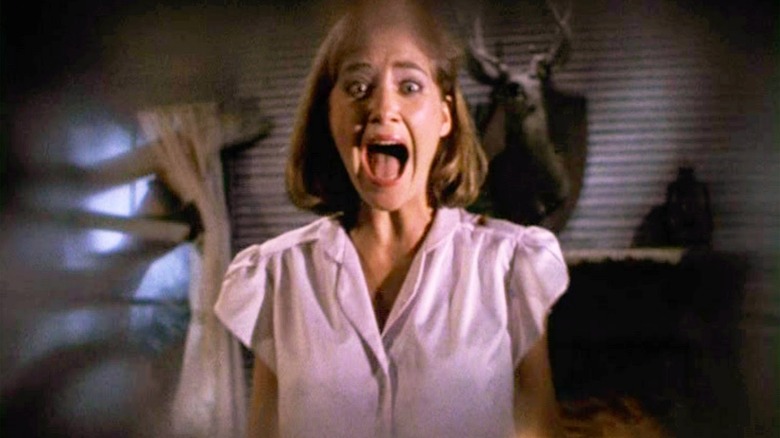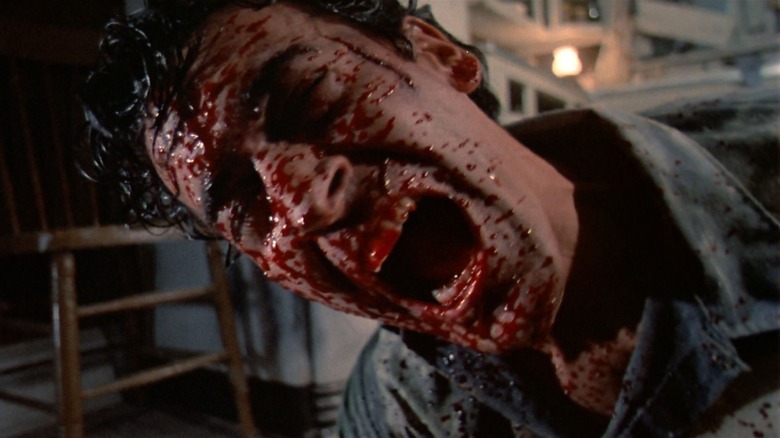How A Legal Loophole Helped Evil Dead 2 Dodge An X-Rating
In the early 1980s in England, a hand-wringing media watchdog group called the National Viewers' and Listeners' Association became distressed by the number of gory and erotic films that had just begun to infiltrate the country's home video marketplace. Because of a censorship loophole, films distributed on VHS didn't need to submit to the British Board of Film Classification, and as a result, all kinds of glorious horror films were making their way to the public with gallons of blood and acres of naked flesh. The NVALA took it upon themselves to locate the worst of the worst, and released a list of 72 movies that were meant to be removed from public viewing. These 72 movies came to be known as the Video Nasties. The classification, of course, only whetted the bloodthirst of horror hounds. It didn't hurt that "Video Nasty" is a pretty metal name to give anything.
One of the Video Nasties was Sam Raimi's 1981 film "The Evil Dead," a fun-loving, ultra-goopy splatter film that has long since been canonized in horror history. In the United States, "The Evil Dead" was released with an X rating (replaced in 1990 by the NC-17 rating), an appellation it bears to this day. Most versions you find on DVD or Blu-ray are more likely the unrated versions. The harsh rating seems churlish to the modern eye, as "The Evil Dead" is such a weirdly whimsical film. One might describe it as a comedy.
You want a R? I'll get you an R.
That's certainly the case for Raimi's 1987 follow-up "Evil Dead II," a film that is just as much Harold Lloyd as it is "Texas Chainsaw." Given the amount of blood and violence in the film — there is a geyser of gore as well as a scene where a human head is chainsawed off ... and then chainsawed in half — it would have most certainly received an X rating. X ratings are, in many markets, the kiss of death. Scuttlebutt in the industry was that certain theaters would refuse to show X-rated movies — the adult film industry has co-opted the term "X-Rated," making any film with the rating tantamount to pornography — and video stored like Blockbuster refused to stock "adult" material.
As detailed in a 1987 article in the Los Angeles Times, "Evil Dead II," thanks to some complicated buying and selling of the film's distribution rights with shell companies, made its way to theaters without having to submit to a ratings board.
"Evil Dead II" was produced by industry veteran Dino De Laurtentiis, whose production company, DEG, would only distribute the movie if it received an R rating from the Motion Picture Association of America. Thanks to all the Video Nasty business with the first film, De Laurentiis was particularly wary of "Evil Dead II" being pilloried for its violence. And, because De Laurentiis was a signatory member of the MPAA, his film would have to be released with whatever the MPAA said. Raimi understood these limitations prior to shooting and promised to make something that would fit under the vague auspices of the R rating.
Definitely an X rating
When the first cut of the film was complete, however, DEG saw that the film would most definitely warrant an X rating. It was DEG's president of distribution, Lawrence Gleason, who felt that if "Evil Dead II" was cut down to a form that would receive an R rating it would, by his estimation, be only 62 minutes long. DEG, as a result of its content, didn't end up distributing the film in the United States. On paper, DEG washed its hands of the whole "Evil Dead II" business.
Instead a new, mysterious distribution company called Rosebud Releasing managed to secure the "Evil Dead II" domestic exhibition rights. This mysterious new company not only somehow managed to get "Evil Dead II" into 340 theaters nationwide, but also mysteriously had paid for an outside ad campaign in newspapers and magazines. Who was Rosebud Releasing and how did they manage to get a nationwide booking and advertising campaign on a movie that was still in ratings limbo?
Rosebud Releasing, it turns out, was a hastily assembled shell company constructed by De Laurentiis and run by his son-in-law Alex De Benedetti, a credited producer on "Evil Dead II." In the Times, Benedetti explained that it was DEG that had already done the booking and advertising. Importantly, in passing "Evil Dead II" over to another producer — even if it was just on paper — it freed the film from needing to submit to the MPAA, De Laurentiis would no longer be beholden to any rating, and no cuts would have to be made.
In the Times article, De Benedetti and Gleason were coy about what kind of financial deal was made with De Laurentiis.
It probably would have gotten an R
When "Evil Dead II" was finally released in March of 1987, Kevin Thomas, the Times' critic, was kind, citing that "Evil Dead II" was more of a comedy than a horror film. Thomas surmised that "Evil Dead II" would likely have gotten an R rating, had the company submitted it to the MPAA. It's entirely possible that Gleason was merely being paranoid.
Because of its light tone and comedic timing, most audiences can look at "Evil Dead II" and subconsciously give it an R rating in their minds. Despite the violence, scary images, and buckets of blood, "Evil Dead II" comes across as goofy and harmless; it is certainly not hard-edged filth. There's a reason generation after generation of teenagers continuously discover "Evil Dead II." It appeals to young comedy nerds and young horror nerds equally.
Dino De Laurentiis spent the 1980s backing a long series of notable horror films, including "Halloween II," "Amityville II: The Possession," "Amitvyille 3-D," "Firestarter,and " Maximum Overdrive," as well as films by David Lynch, David Cronenberg, Michael Cimino, and Curtis Hanson. He was no stranger to the value of horror and the importance of exploring new art.
De Laurentiis doesn't appear to have become embittered by the "Evil Dead II" ratings debacle, as he and Raimi would work together again on the 1992 "Evil Dead" follow-up "Army of Darkness." That film was also rated R, although it probably could have been a PG-13.



